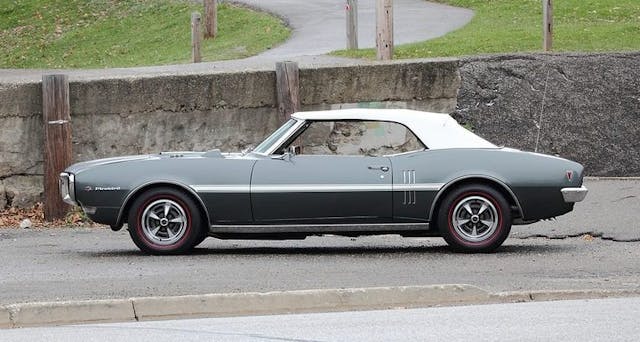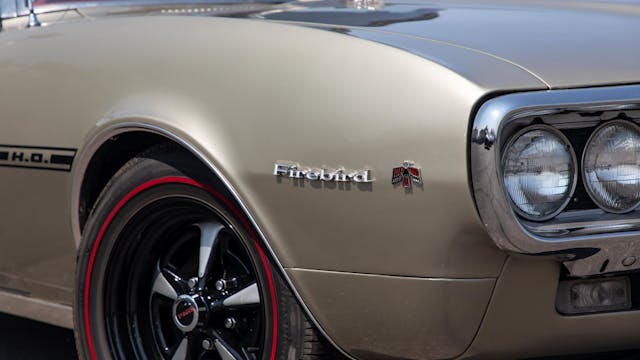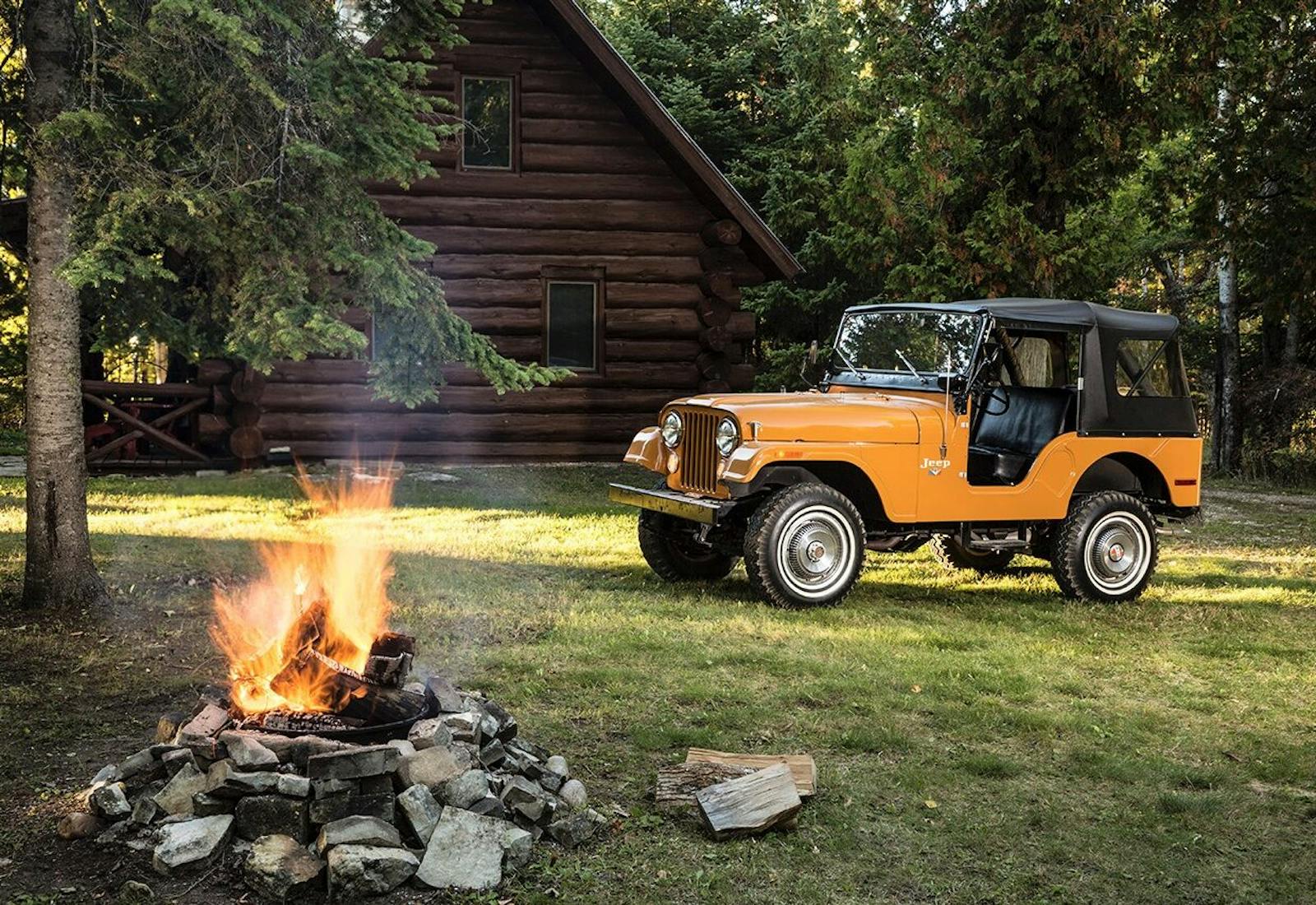Know these 4 common muscle car restoration gaffes to save yourself a costly mistake
Do you find yourself lost when trying to learn concours-caliber details about cars? Are you filled with self-doubt when checking out a car for purchase, especially from afar? You’re not alone, fellow enthusiast! But rather than focus on the nitty gritty that’s out of your league, why don’t we hone on the things that are easy to discern and go from there?
Below are several examples of common restoration mistakes that crop up with popular cars, particular in the muscle car world. Some may be considered negligible, but even the smallest thing that doesn’t add up with a car could be a sign that some deeper scrutiny is in order.
1967–68 Pontiac Firebird and its many stripes
The 1967 Firebird was introduced several months after the Camaro. Unique to the Firebird was five models marketed for different kinds of drivers:
- Firebird
- Firebird Sprint
- Firebird 326
- Firebird H.O.
- Firebird 400
Within these five there was the Magnificent Three, a trio of Firebirds to garner the most desire from enthusiasts: Firebird Sprint, Firebird H.O., and Firebird 400. The sleeper of the bunch was the Firebird H.O. (“High Output”), which consisted of the 4-barrel 326 H.O. for 285 horsepower; for 1968, the H.O.’s engine was bumped to 350 cubic inches and horsepower rose to 320 horses. For both years, the H.O. came standard with a longitudinal stripe with “H.O.” script on the front fender. A similar stripe was optional for other Firebird models but it was continuous without any script.

In recent years, you may have happened across a 1968 Firebird 400 with the H.O. stripe—even in books—but that would be incorrect for the period. The reason for this blunder may have something to do with a new engine upgrade introduced for the 1968 Firebird called the 400 H.O. As the first step-up option for the Firebird 400, this 335-horse engine was essentially equal to the 360-horse 400 H.O. available for the GTO.
However, the Firebird H.O. was its own distinctive model, so the application of the H.O. stripe on a Firebird 400 would be a no-no for purists.

Pontiac decals that never appeared on Pontiacs
Mecum’s recent auction in the Phoenix, Arizona, suburb of Glendale featured a first-generation Firebird with an air cleaner decal that’s commonly seen on Pontiacs at cruises and shows. You may have seen it on Pontiacs with engines ranging from 350, 400, 428, and 455 cu. in.

Perhaps it will surprise you to learn, then, that Pontiac never ever used a decal like this back in the day.
It gets even stranger. If the decal looks somewhat familiar yet you can’t put your finger on why, there’s a reason for that: it was adapted from a Buick design that first appeared in 1969 and lasted through the mid-1970s.

Despite this fact, many restoration catalogs feature this decal for a myriad of Pontiacs, though such example concedes that, “These air cleaner decals for Pontiacs are aftermarket-style only.” Other catalogues are not so forthcoming.
1968 Oldsmobile 4-4-2 stripe
Nineteen sixty-eight was a big year for the 4-4-2 for a number of reasons: a complete redesign brought all-new styling while becoming an actual model instead of a performance package. Additionally, a new long-stroke 400 replaced the short-stroke 400 that had been used since 1965, plus 1967’s Turnpike Cruiser option jumped from the Cutlass Supreme to the 4-4-2 series.

Visually, there was a nifty “W36” Rallye Stripe that was standard on cars equipped with the W30 package and optional for other 4-4-2s. This interesting stripe, which was available in white, black, red, and orange, ran vertically on the front fenders. In recent years, when people apply or paint the stripe, they often do it incorrectly. Witness this example:

Notice how it hits the wheel arch at the bottom? The factory never did it that way. In fact, for cars equipped with the stripe, Oldsmobile moved the 4-4-2 badges slightly towards the door so the stripe could extend uninterrupted to the bottom of the fender. A properly applied stripe will never hit the wheel well, though even that is no guarantee the stripe has been applied to factory specs. Just do an online search and notice the variations.
1969 Plymouth and Dodge 383 engine colors
It seems every other Mopar guy or gal will tell you that the 383 as installed in a 1969 Road Runner was painted orange. Ditto the Super Bee. However, that’s not quite true.

Let’s begin with some history. Both the Road Runner and Super Bee came standard with a 383 rated at 335 horsepower. It was painted orange. Non-performance models like the Belvedere, Satellite, Sport Satellite, and the Coronet Deluxe, 440, and 500 could be equipped with a 383 4-barrel rated at 330 horsepower, and this engine was painted turquoise. The main difference between the two engines was the camshaft.

However, if you ordered a Road Runner or Super Bee with air conditioning, Chrysler downgraded the engine to the milder version, meaning AC-equipped Road Runners and Super Bees featured a turquoise 383. This fact was hardly publicized (though the Dodge dealer album mentions it), but today we have supporting documentation from build sheets and the enthusiasts who understand the archeology. Even more interesting—Chrysler handled this dynamic differently in 1968 and 1970 … though perhaps a story for another time …
What other common, model-specific restoration gaffes can you think of that may serve as red flags? Post them in the comments below.



I have a 1973 Firebird Ram Air Formula 400 and I have two air cleaner lids. I like the aftermarket arrowhead 400-4 Ram Air decal and run it all the time except at Concours car shows when I install the correct plain lid. My car is a Concours first place winner and is correct down to the date coded spark plug wires. I do have an advantage knowing all of the little details though because I bought the car new!
A Roadrunner is basically a hotted up Belvedere-the low price version of the Satellite. The GTX is the hotrod version of the Sport Satellite-the high end of the Belvedere line. You could say there were 5 versions of that body. Of course lots of differences such as the round versus rectangular speedos.
The way many autos were assembled in the ’60’s it would not be a surprise to find most any combination of stuff added, mislocated, or missing. I do recall the parts, fasteners, etc tossed under rear seats.
It’s OK to make it yours if it’s just a Ford or a Chevy but Mopars are so rare and wonderful they deserve to be correct.
Similarly, chrome headlight bezels on ’61 or ’62 Vettes.
The first automobiles I ever got into restoring were Model A’s and then T’s.
25 years ago if I was in a Model A or T I had 30 or 40 guys telling me what was not correct. Now that those older guys have passed on I can drive my Model A pickup or Model T touring and it’s really rare to come across a single soul that knows any different. I never thought I’d ever miss someone picking apart my antiques as if it were under a microscope but I do. Those old guys were a wealth of knowledge that even the internet can’t beat. Back then a comment could mean an hour of conversation. Now it’s “Hey nice ride” and an occasional “What’s that do”
My pet peeve is folks who badge 67 Chevelles as SS 396 cars, change all the badging and leave the Chevelle script on the rear tail panel. Only Malibus have the Chevelle script.
Tough choice for Mopar guys back then: Comfort in the summer or a few extra hp.
Slightly different: I’ve judged numerous car shows (concours to low-rider) and don’t always catch all the bogus details, but as as sort of an expert on the early Datsun Z-cars, I’ve been chastized for marking off ‘stock points’ for cars running alloy wheels, especially the slot-mag style. “But they were on the car when I bought it new!” Yep, and the dealership was looking for some extra gravy by putting a set of four-lug mags on — the ones that fit Falcon/Corvair weren’t selling too well until 1970 — and putting your new (ugly) full wheel-covers on their parts shelf! Datsun didn’t market an alloy rim, amazingly, on new Z’s in the North American market until the last season of the 280Z in ’75, missing all that gravy. Granted, the factory rally cars had one, but it wasn’t sold here. OC, I switched to ARE 8-spokers as soon as I found a set on my HLS3547 bought new; came from a Triumph and had to have the spokes machined slightly on the obverse to clear he disc brake calipers. My current restomod ’71 has 15-in. Konigs. The stock Z hub caps were an embarrassment in ’70! Wick Humble, author of How To Restore Your Datsun Z-Car, 1990– and still in print!
somewhat off topic, because it is not muscle car related, but people who “restore” a WLC Harley with Canadian markings and bolt on a gun scabbard and ammo box on the front forks. NEVER HAPPENED. WLC’s were made for Canada only and did not get the scabbard etc. The WLA was used by the US forces, the lend lease program, and other forces, and did have the scabbard.
This article would be more useful if it had photos of the correct versions of the markings.
After all there is only one correct presentation.
After owning so many cool cars, who cares about little things like this. I once put together a 1985, Chevrolet, k10, short bed with 454, aftermarket efi, sm465 4 speed with 2.73 gears and 33” tires. 15mpg running 65 mph @ wait for it… 1500 rpm! It ran and drove perfect and was awesome! Everyone was on me about the high gears, until they went for a ride with me!!!! We humans worry about the silliest things.
Paint
Keeping miles low
Staying “all oem”
Correct this, correct that bla bla bla
Then own something for years and years and never get to enjoy it! Then “the old man passes” the whole project gets sold!!
Not me…. 🙂
I had a 67 Firebird 326HO, It had no stripping at all. (Factory Delete) It was every bit a sleeper. Very fast car. 67 was the only year that used a Carter AFB instead of a Q-Jet. When I got rid of it, it had a twin scoop 400 hood and a Z28 rear spoiler. (The spoiler was a perfect fit). I’ll bet this would drive some restorer nuts.
Another MoPar restoration snaffu is not painting the from of the radiator support black. Chrysler never intended to see body color through the grill.